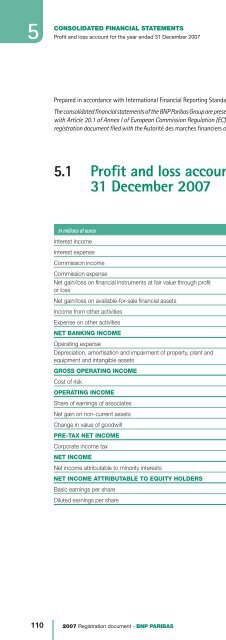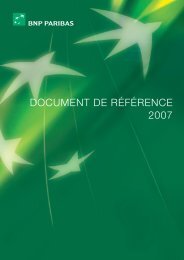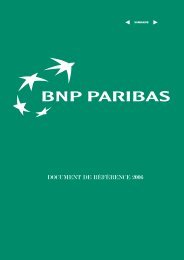2007 REGISTRATION DOCUMENT
2007 REGISTRATION DOCUMENT
2007 REGISTRATION DOCUMENT
- No tags were found...
Create successful ePaper yourself
Turn your PDF publications into a flip-book with our unique Google optimized e-Paper software.
5 NotesCONSOLIDATED FINANCIAL STATEMENTSto the financial s tatements p repared in accordance with I nternational Financial Reporting S tandards as adopted by the European Union< Contents >31 December <strong>2007</strong> 31 December 2006In millions of euros Carrying value (1) Estimated fair value Carrying value (1) Estimated fair valueFINANCIAL ASSETSLoans and receivables due from credit institutions 71,116 70,846 75,170 75,439Loans and receivables due from customers 445,103 441,939 393,133 392,600Held-to-maturity fi nancial assets 14,808 15,083 15,149 15,628FINANCIAL LIABILITIESDue to credit institutions 170,182 169,919 143,650 143,906Due to customers 346,704 346,645 298,652 298,678Debt securities 141,056 140,495 121,559 121,429Subordinated debt 18,641 18,100 17,960 18,127(1)The carrying amount does not include the remeasurement of portfolios of financial instruments in fair value hedging relationships. At 31 December <strong>2007</strong>, this isincluded within “Remeasurement adjustment on interest-rate risk hedged portfolios” under assets in a negative amount of EUR 264 million, and under liabilitiesfor a positive amount of EUR 20 million (respectively, a negative amount of EUR 295 million and a positive amount of EUR 367 million at 31 December 2006).123The fair values shown above relate solely to financial instrumentsrecognised in the balance sheet, and hence do not include non-financialassets and liabilities.The fair value of a financial instrument is defined as the amount forwhich an asset could be exchanged, or a liability settled, betweenknowledgeable, willing parties in an arm’s length transaction.The valuation techniques and assumptions used by BNP Paribas ensurethat the fair value of financial assets and liabilities is measured on aconsistent basis throughout the Group. Fair value is based on pricesquoted in an active market when these are available. In other cases, fairvalue is determined using valuation techniques such as discounting ofestimated future cash flows for loans, liabilities and held-to-maturityfinancial assets, or specific valuation models for other financialinstruments as described in Note 1, “Principal accounting policies appliedby the BNP Paribas Group”. In the case of loans, liabilities and heldto-maturityfinancial assets that have an initial maturity of less thanone year (including demand deposits) or are granted on floating-rateterms, fair value equates to carrying amount. The same applies to mostregulated savings products.In 2006, the valuation techniques implemented to comply with IFRSdisclosure requirements and to measure the financial instrumentscomprising the banking intermediation book are based on assumptionof stable credit spreads. In <strong>2007</strong>, the change in market conditions over theyear revealed a widening of spreads on bank financing and investmentactivities from approximately 10 basis points for clients having the threehighest ratings in the bank’s internal rating system to approximately200 basis points for clients having the lowest rating. These observedchanges were taken into account in the fair value estimated for financialassets at 31 December <strong>2007</strong>. Debt securities with residual maturities ofmore than one year were measured assuming a widening in the Bank’sspread of approximately 10 basis points, which is consistent with thechange in spread taken into account in the measurement of the debtat fair value through profit and loss; in the case of subordinated debt,the widening in the Bank’s spread taken into account in the valuationwas approximately 60 basis points.4567891011220<strong>2007</strong> Registration document - BNP PARIBAS
















